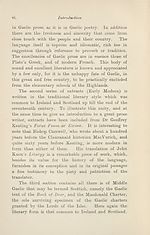Download files
Complete book:
Individual page:
Thumbnail gallery: Grid view | List view

INTRODUCTION
The extracts contained in this little book fall into
three divisions—
(1) Modern Scott'sh Gaelic, from 1700 to the
present day (pp. 1-141).
(2) Early Modern Gaelic: circ. 1500 to 1700
(pp. 141-181).
(3) Middle Gaelic: circ. 1000-1500 (pp. 181-192).
The examples from the first of these three periods are
distinctively Scottish, being uninfluenced by Irish
tradition. To this period belongs the great bulk of
our Gaelic prose, and much of it is of high literary
quality. Of one of the Rev. Dr Norman Macleod’s
writings Professor Blackie says that “ for graceful
simplicity and profound pathos, it is second to nothing
that I know in any language, unless, indeed, it be the
account of the death of Socrates in Plato’s Phaedo,
and some well-known chapters in the Gospel of St
John.” The piece referred to, Long Mh6r nan
Eilthireach, is indeed a fine example of restrained and
dignified pathos, and in Dr Macleod’s hands, Gaelic
proved itself a vehicle not less effective of gaiety, of
humour, and of orderly exposition. Yet Dr Macleod
was not the only great Gaelic writer of his day, and
since his time there have been, and are still, many
writers whose work will bear comparison with the best.
The quality of graceful simplicity seems to be inherent
The extracts contained in this little book fall into
three divisions—
(1) Modern Scott'sh Gaelic, from 1700 to the
present day (pp. 1-141).
(2) Early Modern Gaelic: circ. 1500 to 1700
(pp. 141-181).
(3) Middle Gaelic: circ. 1000-1500 (pp. 181-192).
The examples from the first of these three periods are
distinctively Scottish, being uninfluenced by Irish
tradition. To this period belongs the great bulk of
our Gaelic prose, and much of it is of high literary
quality. Of one of the Rev. Dr Norman Macleod’s
writings Professor Blackie says that “ for graceful
simplicity and profound pathos, it is second to nothing
that I know in any language, unless, indeed, it be the
account of the death of Socrates in Plato’s Phaedo,
and some well-known chapters in the Gospel of St
John.” The piece referred to, Long Mh6r nan
Eilthireach, is indeed a fine example of restrained and
dignified pathos, and in Dr Macleod’s hands, Gaelic
proved itself a vehicle not less effective of gaiety, of
humour, and of orderly exposition. Yet Dr Macleod
was not the only great Gaelic writer of his day, and
since his time there have been, and are still, many
writers whose work will bear comparison with the best.
The quality of graceful simplicity seems to be inherent
Set display mode to:
![]() Universal Viewer |
Universal Viewer | ![]() Mirador |
Large image | Transcription
Mirador |
Large image | Transcription
| An Comunn Gàidhealach > An Comunn Gàidhealach Publications > Rosg Gaidhlig > (9) |
|---|
| Permanent URL | https://digital.nls.uk/126277496 |
|---|
| Description | This contains items published by An Comunn, which are not specifically Mòd-related. It includes journals, annual reports and corporate documents, policy statements, educational resources and published plays and literature. It is arranged alphabetically by title. |
|---|
| Description | A collection of over 400 items published by An Comunn Gàidhealach, the organisation which promotes Gaelic language and culture and organises the Royal National Mòd. Dating from 1891 up to the present day, the collection includes journals and newspapers, annual reports, educational materials, national Mòd programmes, published Mòd literature and music. |
|---|---|
| Additional NLS resources: |
|

